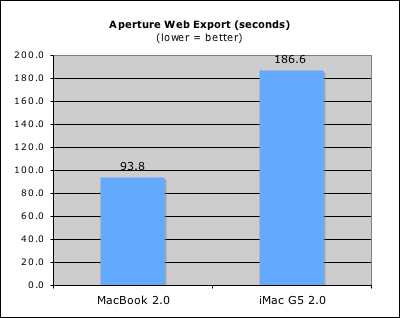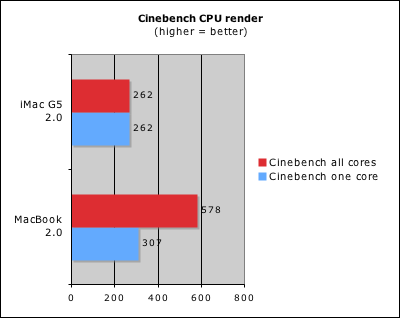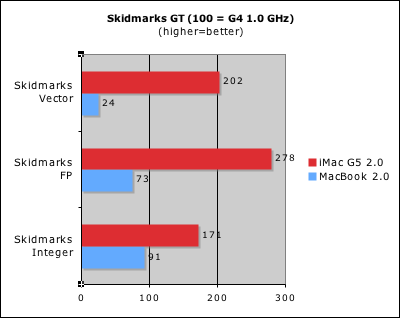We tested Photoshop CS2 using the www.retouchartists.com Photoshop benchmark, which consists of a 3.42 MB file run through a battery of scripted Photoshop actions.

Not surprisingly, the iMac easily bests the MacBook, since Photoshop is running natively on the single-core G5 and under Rosetta on the dual-core MacBook. The difference was about 25%.
What was interesting to note though was the fact that although the MacBook had 2.0 GB of RAM, it paged out to the hard drive much more often than the 1.0 GB G4 Power Mac Cube and the iMac. In fact, that 1.5 GB iMac G5 never paged to disk at all. However, further checking revealed the iMac had only 50% of it's 1.5 GB (735 MB) allocated to Photoshop, whereas the MacBook had 70% of its 2.0 GB (1374 MB) allocated. I repeated the test on the MacBook with it also set to 50% (981 MB) and curiously, all the pageouts disappeared, but the time was almost exactly the same, this time taking 3 seconds longer. I'm not sure exactly why I got the results I got, but suffice it to say that Photoshop on the MacBook under Rosetta isn't particularly fast, with the test times with both settings both noticeably longer than the iMac's.
The second benchmark I did was simply to test Exposé performance with a lot of windows open. Both the iMac and the MacBook were connected up via VGA to a Dell W2606C LCD TV with a 1360x768 screen resolution. All other windows were closed, but multiple Safari windows measuring 1013x772 in size were opened, until Exposé began to lag.
Exposé stutter threshold (Higher is better)The fact that the iMac could open around twice as many windows before lagging sounds about right considering that the iMac has 128 MB video RAM with its Radeon 9600, twice the 64 MB on the MacBook. On Apple's MacBook page, it hints that GMA 950 may be able to use more than 64 MB in OS X. It says "Memory available to Mac OS X may vary depending on graphics needs. Minimum graphics memory usage is 80MB", but in tests the Apple System Profiler continued to state a 64 MB video RAM allocation, and the Exposé lag persisted after repeated Exposé activation. Note though that with just the MacBook screen (without the additional external screen), Exposé could handle many more open windows before it began to stutter. Basically what this test means is that ideally for a dual-monitor 2D setup, 128 MB is preferred if you wish to maintain smooth-as-butter GUI eye candy. For a single 1280x800 screen however, 64 MB is fine. This result concurs with the Exposé results from the AnandTech Power Mac G5 review from a couple of years ago. In that test they felt that the 64 MB Radeon 9600 was insufficient for good dual-screen Exposé, but a video card with more memory worked great.
iMac G5: 31 Safari windows
MacBook: 15 Safari windows
2007 may prove to be an interesting year for the MacBook. Photoshop will go Intel native in 2007. Also, by then the MacBook will most likely have an updated GPU, and it's possible that Apple could change the OS X GPU shared memory setting to include a 128 MB (or more) option, at least in OS X 10.5 Leopard. It's true that for most practical non-3D work, the MacBook is very responsive already, but the new features could make the MacBook an even more complete all-in-one small laptop.
 Now that I've had a few days with my MacBook with new RAM installed, I've been able to properly compare the performance in various applications on my my MacBook and my iMac G5. My MacBook has 2 GB of PC2-5300 RAM, an 80 GB 5400 rpm 2.5" drive, Intel GMA 950 graphics (using 64 MB system RAM), and a Core Duo 2.0 CPU. The iMac has 1.5 GB of PC-3200 RAM, a 500 GB 7200 rpm 3.5" drive, Radeon 9600 graphics (with 128 MB dedicated video RAM), and a G5 970FX 2.0 (single-core).
Now that I've had a few days with my MacBook with new RAM installed, I've been able to properly compare the performance in various applications on my my MacBook and my iMac G5. My MacBook has 2 GB of PC2-5300 RAM, an 80 GB 5400 rpm 2.5" drive, Intel GMA 950 graphics (using 64 MB system RAM), and a Core Duo 2.0 CPU. The iMac has 1.5 GB of PC-3200 RAM, a 500 GB 7200 rpm 3.5" drive, Radeon 9600 graphics (with 128 MB dedicated video RAM), and a G5 970FX 2.0 (single-core).




